Colorado State University: Leadership and Teams Report (ORG500)
VerifiedAdded on 2019/10/18
|6
|1051
|173
Report
AI Summary
This report delves into the realm of leadership and team dynamics, beginning with an exploration of leadership models, specifically focusing on Blake and Mouton's leadership grid. This model is thoroughly examined, highlighting its two dimensions: concern for people and concern for production, and how these dimensions create distinct leadership styles such as impoverished management, task management, middle-of-the-road, country club, and team management. The report then transitions to contemporary leadership theory, with an in-depth analysis of servant leadership, emphasizing its core principles of prioritizing follower needs, building community, and sharing power. A real-world example is provided, illustrating the practical application of servant leadership in an organization and its positive impact on employee efficiency and satisfaction. The report concludes by highlighting the strengths of servant leadership, such as improved leader-employee relationships and increased productivity.
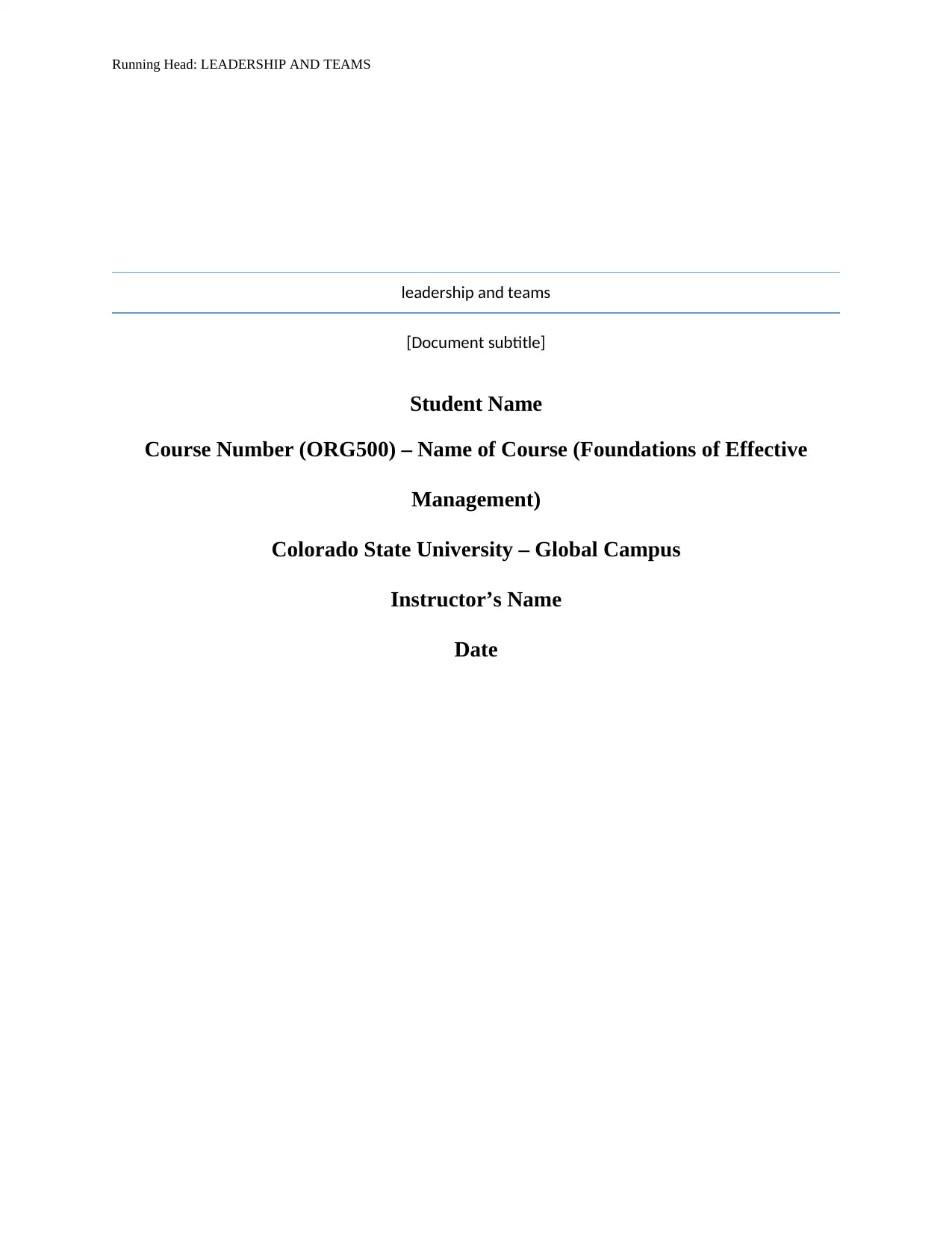
Running Head: LEADERSHIP AND TEAMS
leadership and teams
[Document subtitle]
Student Name
Course Number (ORG500) – Name of Course (Foundations of Effective
Management)
Colorado State University – Global Campus
Instructor’s Name
Date
leadership and teams
[Document subtitle]
Student Name
Course Number (ORG500) – Name of Course (Foundations of Effective
Management)
Colorado State University – Global Campus
Instructor’s Name
Date
Paraphrase This Document
Need a fresh take? Get an instant paraphrase of this document with our AI Paraphraser
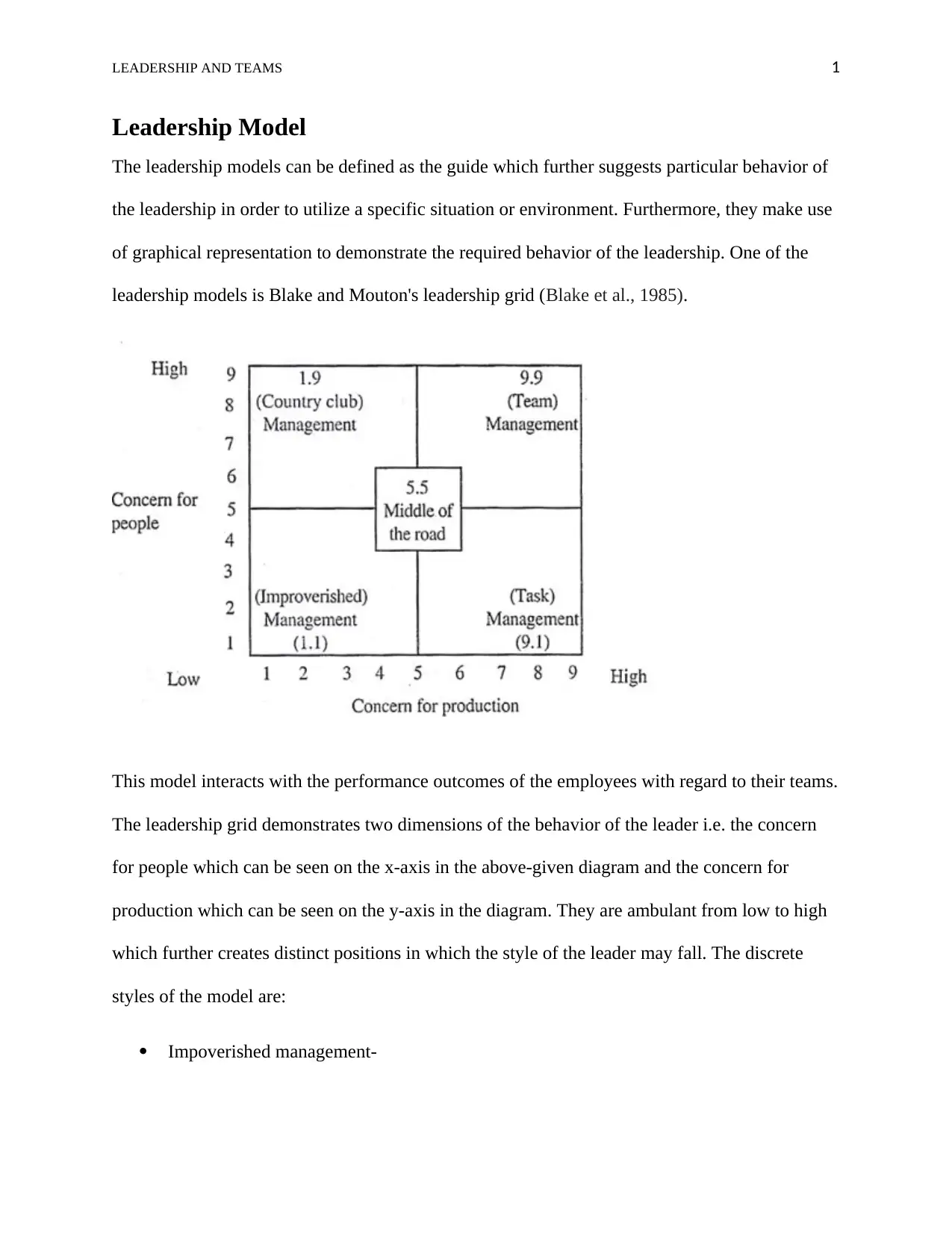
LEADERSHIP AND TEAMS 1
Leadership Model
The leadership models can be defined as the guide which further suggests particular behavior of
the leadership in order to utilize a specific situation or environment. Furthermore, they make use
of graphical representation to demonstrate the required behavior of the leadership. One of the
leadership models is Blake and Mouton's leadership grid (Blake et al., 1985).
This model interacts with the performance outcomes of the employees with regard to their teams.
The leadership grid demonstrates two dimensions of the behavior of the leader i.e. the concern
for people which can be seen on the x-axis in the above-given diagram and the concern for
production which can be seen on the y-axis in the diagram. They are ambulant from low to high
which further creates distinct positions in which the style of the leader may fall. The discrete
styles of the model are:
Impoverished management-
Leadership Model
The leadership models can be defined as the guide which further suggests particular behavior of
the leadership in order to utilize a specific situation or environment. Furthermore, they make use
of graphical representation to demonstrate the required behavior of the leadership. One of the
leadership models is Blake and Mouton's leadership grid (Blake et al., 1985).
This model interacts with the performance outcomes of the employees with regard to their teams.
The leadership grid demonstrates two dimensions of the behavior of the leader i.e. the concern
for people which can be seen on the x-axis in the above-given diagram and the concern for
production which can be seen on the y-axis in the diagram. They are ambulant from low to high
which further creates distinct positions in which the style of the leader may fall. The discrete
styles of the model are:
Impoverished management-
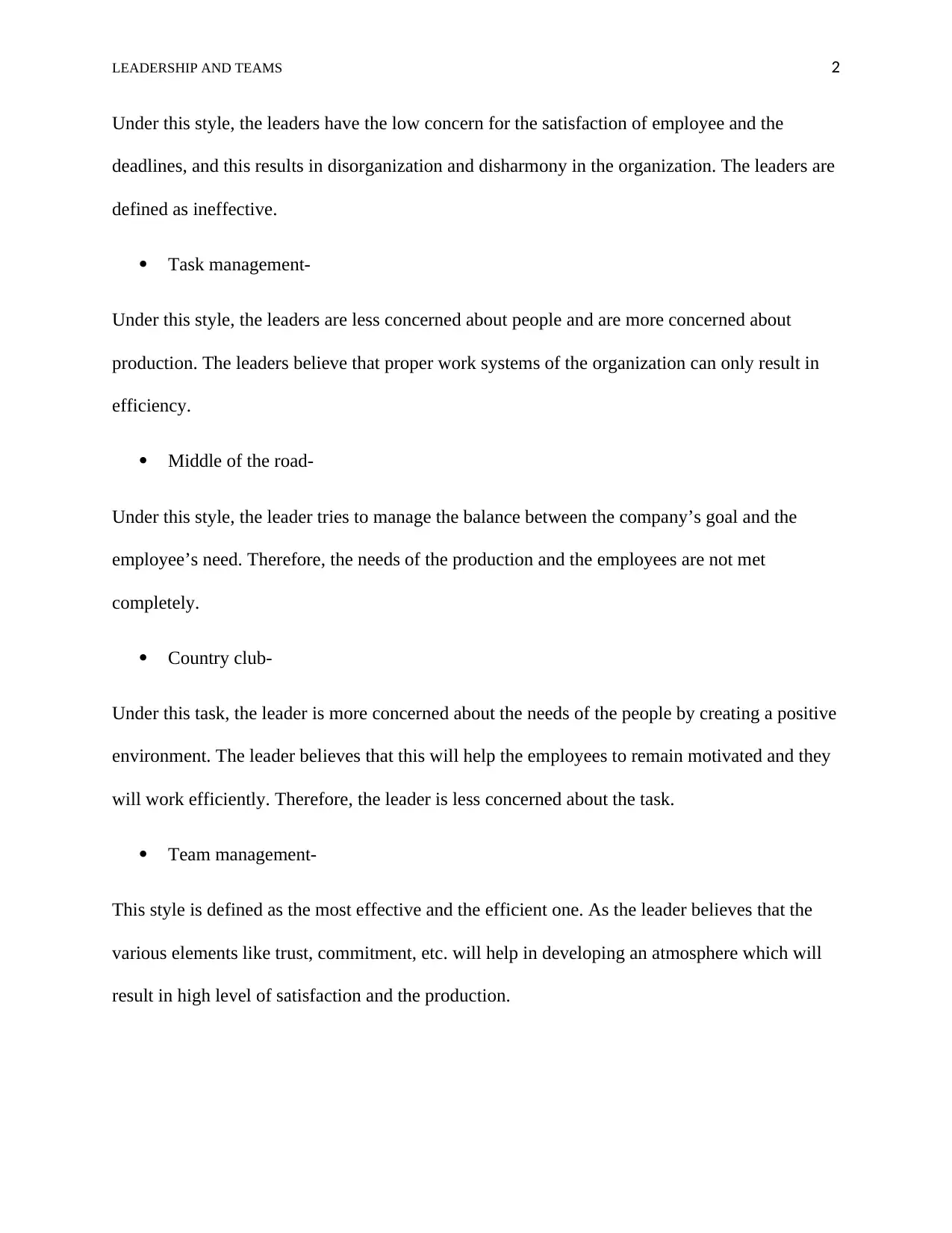
LEADERSHIP AND TEAMS 2
Under this style, the leaders have the low concern for the satisfaction of employee and the
deadlines, and this results in disorganization and disharmony in the organization. The leaders are
defined as ineffective.
Task management-
Under this style, the leaders are less concerned about people and are more concerned about
production. The leaders believe that proper work systems of the organization can only result in
efficiency.
Middle of the road-
Under this style, the leader tries to manage the balance between the company’s goal and the
employee’s need. Therefore, the needs of the production and the employees are not met
completely.
Country club-
Under this task, the leader is more concerned about the needs of the people by creating a positive
environment. The leader believes that this will help the employees to remain motivated and they
will work efficiently. Therefore, the leader is less concerned about the task.
Team management-
This style is defined as the most effective and the efficient one. As the leader believes that the
various elements like trust, commitment, etc. will help in developing an atmosphere which will
result in high level of satisfaction and the production.
Under this style, the leaders have the low concern for the satisfaction of employee and the
deadlines, and this results in disorganization and disharmony in the organization. The leaders are
defined as ineffective.
Task management-
Under this style, the leaders are less concerned about people and are more concerned about
production. The leaders believe that proper work systems of the organization can only result in
efficiency.
Middle of the road-
Under this style, the leader tries to manage the balance between the company’s goal and the
employee’s need. Therefore, the needs of the production and the employees are not met
completely.
Country club-
Under this task, the leader is more concerned about the needs of the people by creating a positive
environment. The leader believes that this will help the employees to remain motivated and they
will work efficiently. Therefore, the leader is less concerned about the task.
Team management-
This style is defined as the most effective and the efficient one. As the leader believes that the
various elements like trust, commitment, etc. will help in developing an atmosphere which will
result in high level of satisfaction and the production.
⊘ This is a preview!⊘
Do you want full access?
Subscribe today to unlock all pages.

Trusted by 1+ million students worldwide
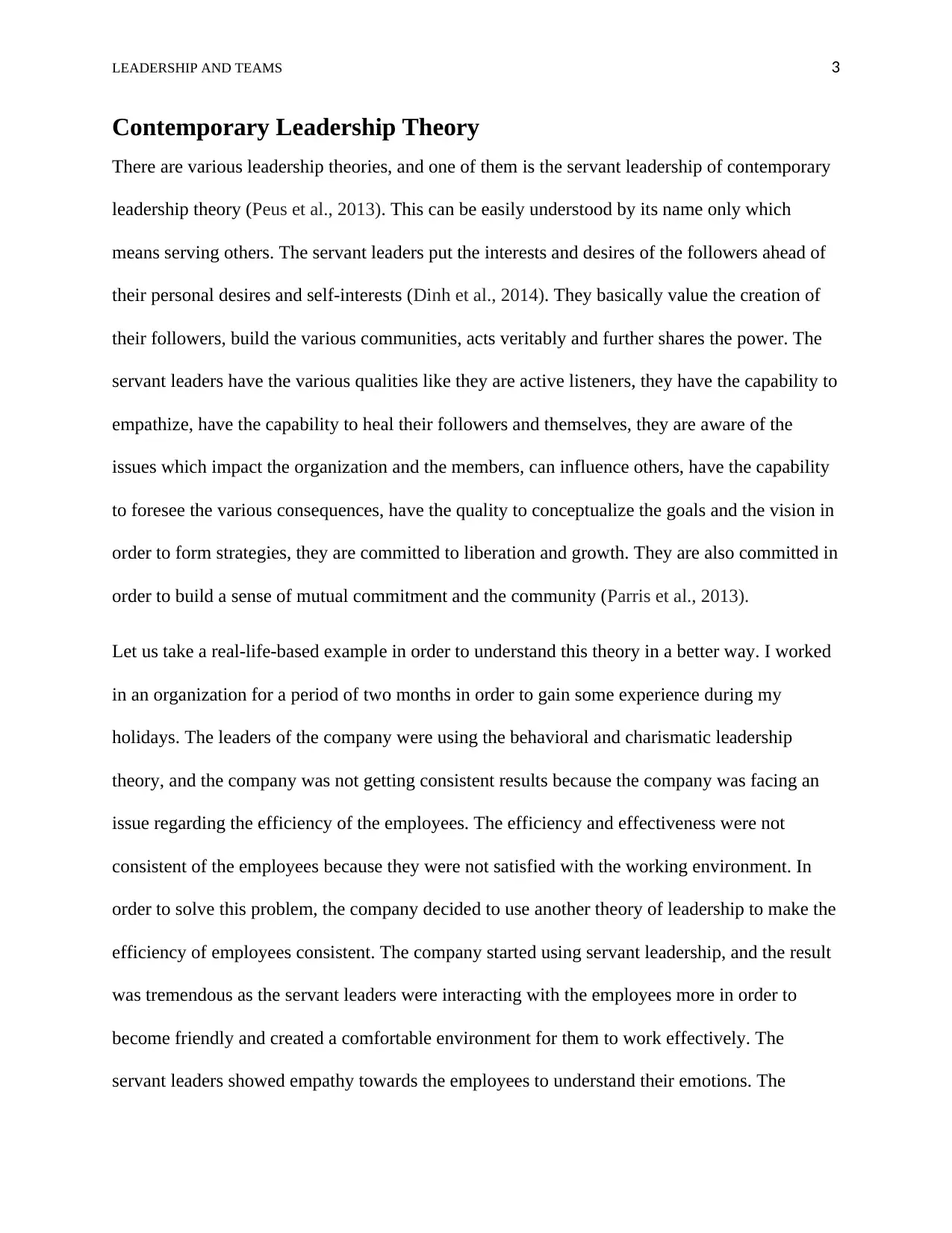
LEADERSHIP AND TEAMS 3
Contemporary Leadership Theory
There are various leadership theories, and one of them is the servant leadership of contemporary
leadership theory (Peus et al., 2013). This can be easily understood by its name only which
means serving others. The servant leaders put the interests and desires of the followers ahead of
their personal desires and self-interests (Dinh et al., 2014). They basically value the creation of
their followers, build the various communities, acts veritably and further shares the power. The
servant leaders have the various qualities like they are active listeners, they have the capability to
empathize, have the capability to heal their followers and themselves, they are aware of the
issues which impact the organization and the members, can influence others, have the capability
to foresee the various consequences, have the quality to conceptualize the goals and the vision in
order to form strategies, they are committed to liberation and growth. They are also committed in
order to build a sense of mutual commitment and the community (Parris et al., 2013).
Let us take a real-life-based example in order to understand this theory in a better way. I worked
in an organization for a period of two months in order to gain some experience during my
holidays. The leaders of the company were using the behavioral and charismatic leadership
theory, and the company was not getting consistent results because the company was facing an
issue regarding the efficiency of the employees. The efficiency and effectiveness were not
consistent of the employees because they were not satisfied with the working environment. In
order to solve this problem, the company decided to use another theory of leadership to make the
efficiency of employees consistent. The company started using servant leadership, and the result
was tremendous as the servant leaders were interacting with the employees more in order to
become friendly and created a comfortable environment for them to work effectively. The
servant leaders showed empathy towards the employees to understand their emotions. The
Contemporary Leadership Theory
There are various leadership theories, and one of them is the servant leadership of contemporary
leadership theory (Peus et al., 2013). This can be easily understood by its name only which
means serving others. The servant leaders put the interests and desires of the followers ahead of
their personal desires and self-interests (Dinh et al., 2014). They basically value the creation of
their followers, build the various communities, acts veritably and further shares the power. The
servant leaders have the various qualities like they are active listeners, they have the capability to
empathize, have the capability to heal their followers and themselves, they are aware of the
issues which impact the organization and the members, can influence others, have the capability
to foresee the various consequences, have the quality to conceptualize the goals and the vision in
order to form strategies, they are committed to liberation and growth. They are also committed in
order to build a sense of mutual commitment and the community (Parris et al., 2013).
Let us take a real-life-based example in order to understand this theory in a better way. I worked
in an organization for a period of two months in order to gain some experience during my
holidays. The leaders of the company were using the behavioral and charismatic leadership
theory, and the company was not getting consistent results because the company was facing an
issue regarding the efficiency of the employees. The efficiency and effectiveness were not
consistent of the employees because they were not satisfied with the working environment. In
order to solve this problem, the company decided to use another theory of leadership to make the
efficiency of employees consistent. The company started using servant leadership, and the result
was tremendous as the servant leaders were interacting with the employees more in order to
become friendly and created a comfortable environment for them to work effectively. The
servant leaders showed empathy towards the employees to understand their emotions. The
Paraphrase This Document
Need a fresh take? Get an instant paraphrase of this document with our AI Paraphraser
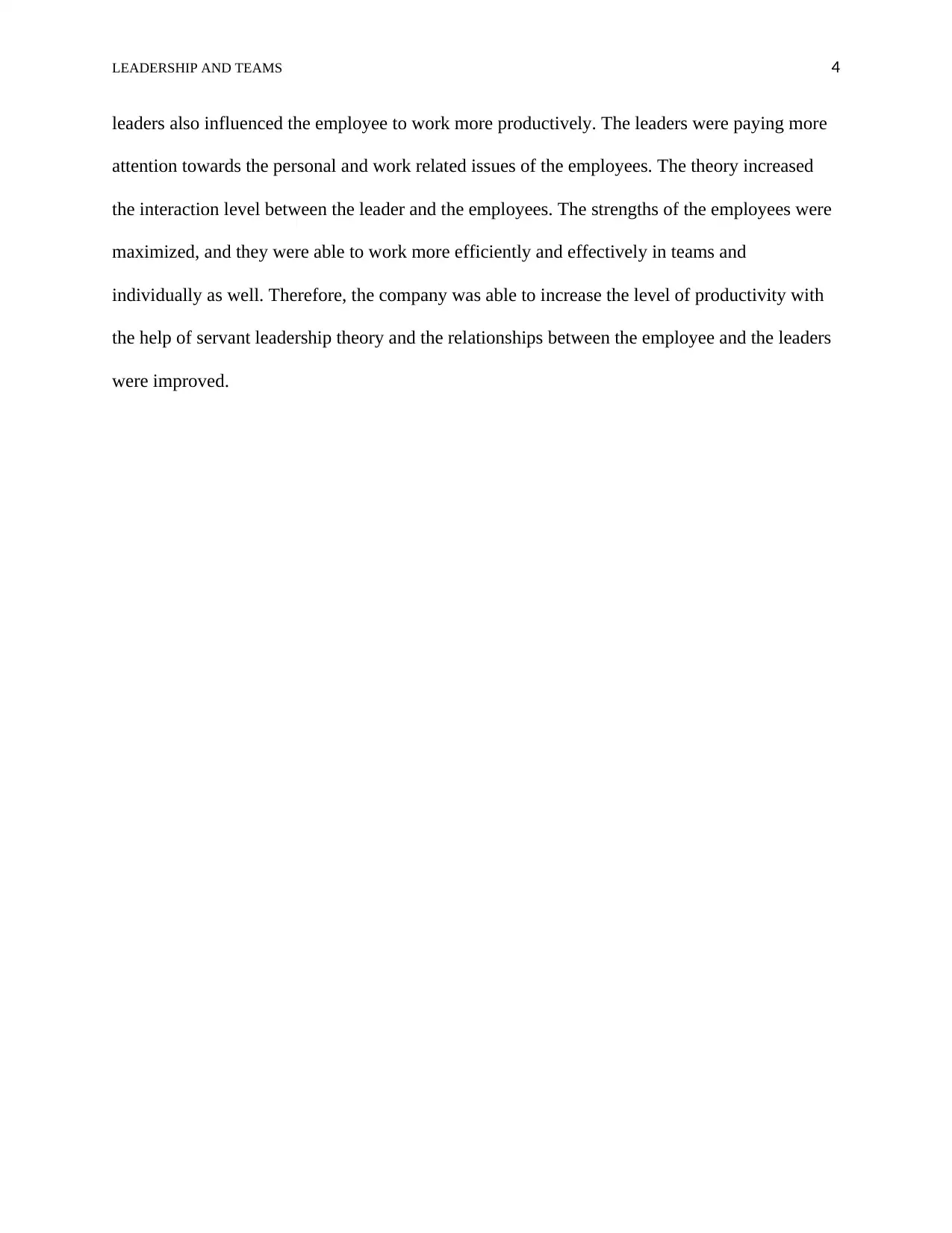
LEADERSHIP AND TEAMS 4
leaders also influenced the employee to work more productively. The leaders were paying more
attention towards the personal and work related issues of the employees. The theory increased
the interaction level between the leader and the employees. The strengths of the employees were
maximized, and they were able to work more efficiently and effectively in teams and
individually as well. Therefore, the company was able to increase the level of productivity with
the help of servant leadership theory and the relationships between the employee and the leaders
were improved.
leaders also influenced the employee to work more productively. The leaders were paying more
attention towards the personal and work related issues of the employees. The theory increased
the interaction level between the leader and the employees. The strengths of the employees were
maximized, and they were able to work more efficiently and effectively in teams and
individually as well. Therefore, the company was able to increase the level of productivity with
the help of servant leadership theory and the relationships between the employee and the leaders
were improved.
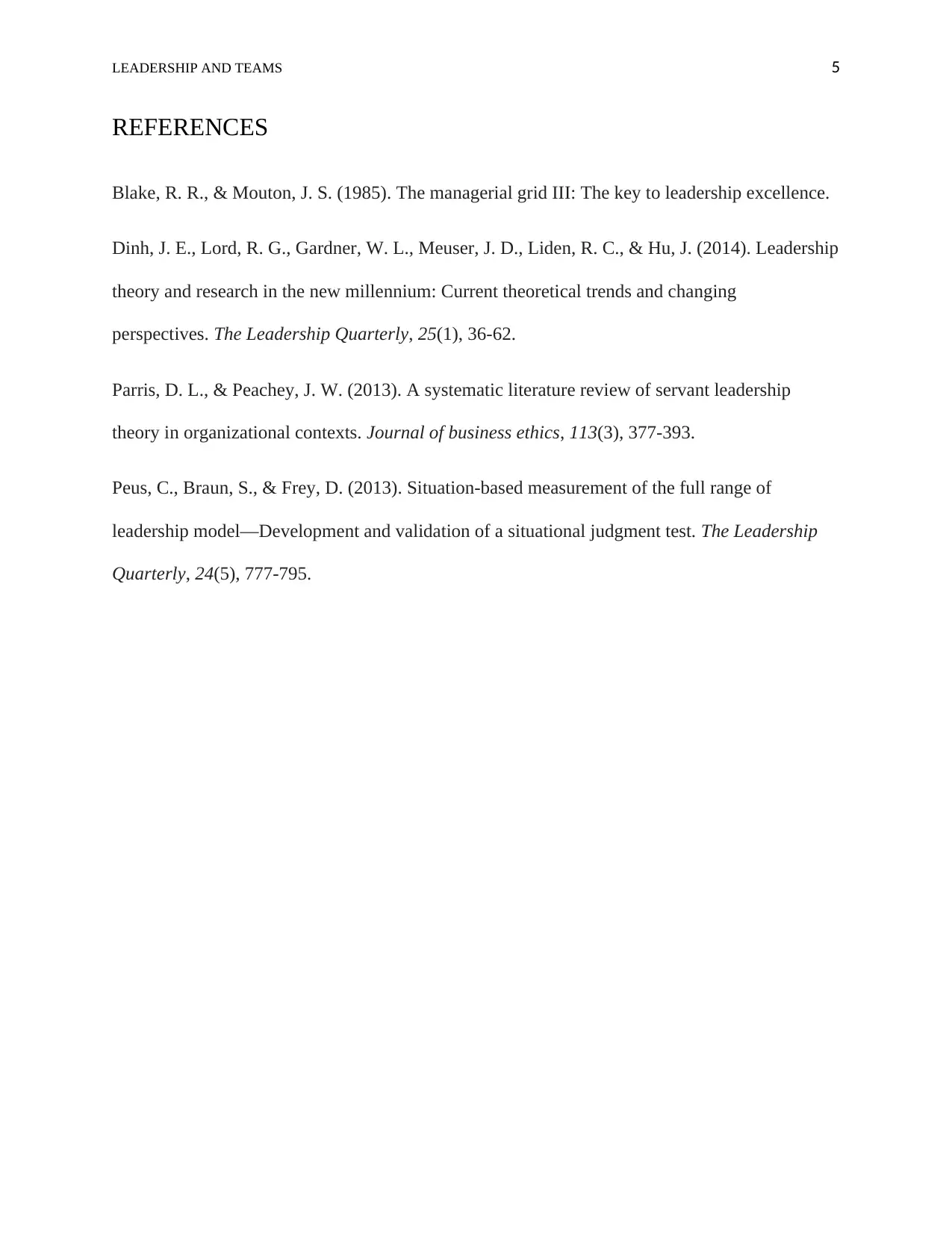
LEADERSHIP AND TEAMS 5
REFERENCES
Blake, R. R., & Mouton, J. S. (1985). The managerial grid III: The key to leadership excellence.
Dinh, J. E., Lord, R. G., Gardner, W. L., Meuser, J. D., Liden, R. C., & Hu, J. (2014). Leadership
theory and research in the new millennium: Current theoretical trends and changing
perspectives. The Leadership Quarterly, 25(1), 36-62.
Parris, D. L., & Peachey, J. W. (2013). A systematic literature review of servant leadership
theory in organizational contexts. Journal of business ethics, 113(3), 377-393.
Peus, C., Braun, S., & Frey, D. (2013). Situation-based measurement of the full range of
leadership model—Development and validation of a situational judgment test. The Leadership
Quarterly, 24(5), 777-795.
REFERENCES
Blake, R. R., & Mouton, J. S. (1985). The managerial grid III: The key to leadership excellence.
Dinh, J. E., Lord, R. G., Gardner, W. L., Meuser, J. D., Liden, R. C., & Hu, J. (2014). Leadership
theory and research in the new millennium: Current theoretical trends and changing
perspectives. The Leadership Quarterly, 25(1), 36-62.
Parris, D. L., & Peachey, J. W. (2013). A systematic literature review of servant leadership
theory in organizational contexts. Journal of business ethics, 113(3), 377-393.
Peus, C., Braun, S., & Frey, D. (2013). Situation-based measurement of the full range of
leadership model—Development and validation of a situational judgment test. The Leadership
Quarterly, 24(5), 777-795.
⊘ This is a preview!⊘
Do you want full access?
Subscribe today to unlock all pages.

Trusted by 1+ million students worldwide
1 out of 6
Related Documents
Your All-in-One AI-Powered Toolkit for Academic Success.
+13062052269
info@desklib.com
Available 24*7 on WhatsApp / Email
![[object Object]](/_next/static/media/star-bottom.7253800d.svg)
Unlock your academic potential
Copyright © 2020–2025 A2Z Services. All Rights Reserved. Developed and managed by ZUCOL.





